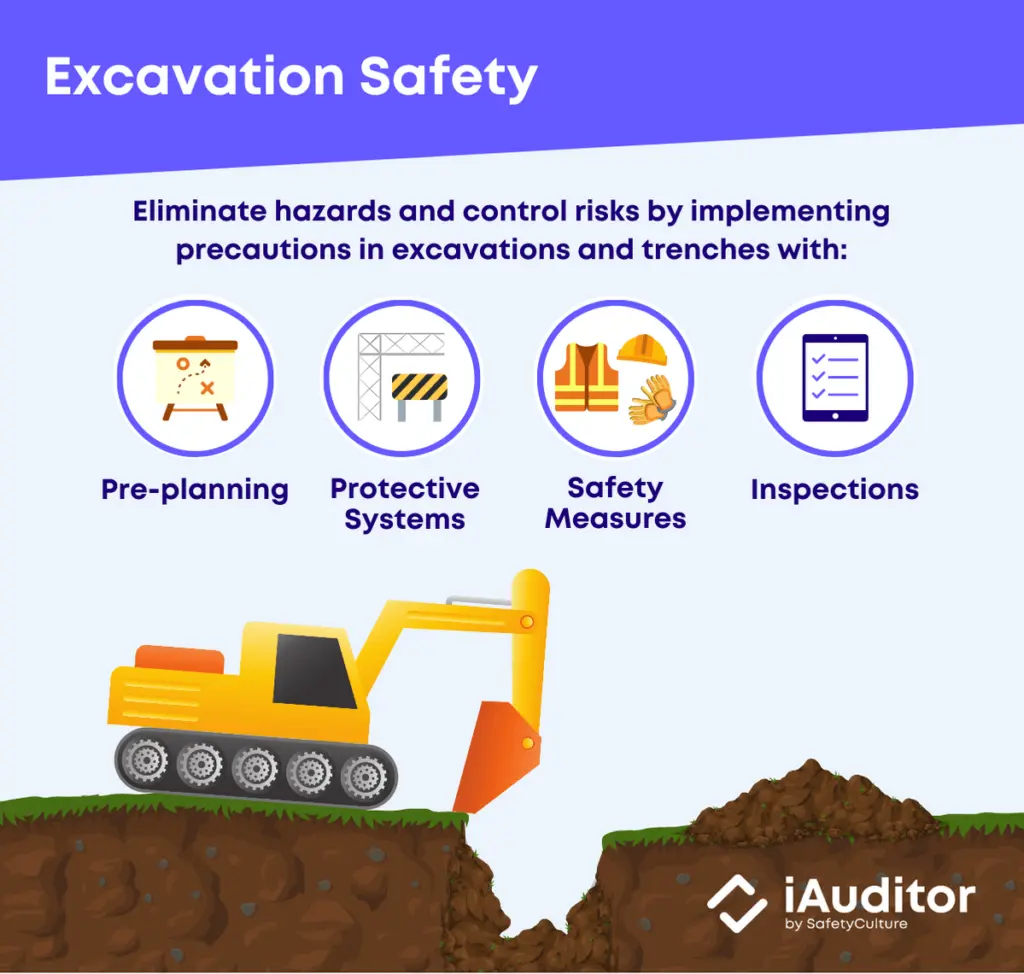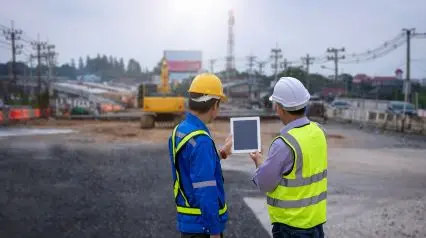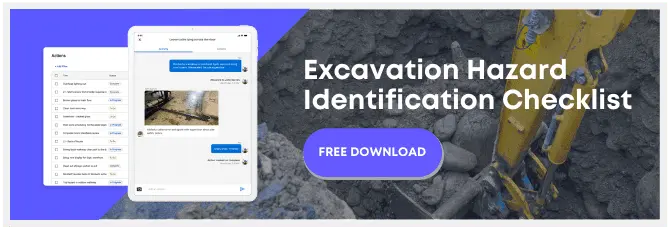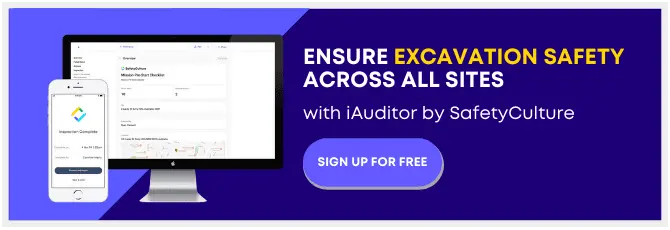What is Excavation Safety?
Excavation Safety is a standardized set of safety precautions for trenching and excavation to eliminate hazards and control risks in compliance with regulations. It is also referred to as Trenching and Excavation Safety as often cited by the U.S. Occupational Safety and Health Administration (OSHA).

What are OSHA Excavation Standards?
OSHA excavation standards are specifications of requirements for trenching and excavation, including protective systems. In U.S. federal regulations, OSHA standards for excavations and backfilling are specifically found in Title 29 (Labor) Part 1926 (Safety and Health Regulations for Construction) Subpart P (Excavations), or 29 CFR 1926 subpart P. The excavation regulation also contains appendices for the following:
- Soil Classification;
- Sloping and Benching;
- Timber Shoring for Trenches;
- Aluminum Hydraulic Shoring for Trenches;
- Alternatives to Timber Shoring; and
- Selection of Protective Systems.
What is the Difference Between Trenching and Excavation?
The scope and application of excavation standards states that excavations include trenches which means that a trench is a type of excavation. Moreover, a trench is further defined as a narrow excavation in relation to its length, and it is generally greater in depth than width. The main difference is that “excavation” is the umbrella term that encompasses any man-made cut in an earth surface, including trenches. While a trench can be called a trench excavation and all trenches are excavations, not all excavations are made up of trenches only.
Why is Excavation and Trench Safety Important?
Excavation and trenching are amongst the most dangerous operations in the construction industry. Dangers can include cave-ins, falling loads, hazardous atmospheres, and hazards from using heavy equipment. Regular pre-work inspections can reduce hazards and serious risk of injury. Safety inspections should check for the type of excavation being conducted, support and warning systems in place, access areas, weather conditions, heavy equipment, PPE, and other assets needed.
What are the Hazards in Excavation?
“As any man-made cut, cavity, trench, or depression in the Earth’s surface formed by earth removal,” according to the OHSA definition, excavations involve many hazards. Here are some of the dangers brought by excavations:
- The collapse of the sides of the excavation
- Materials falling onto people
- Falls, either people or vehicles
- Nearby structures collapsing into the excavation
- Electrocution, explosion, blasts, gas leak, or flooding, caused by damage to underground services
What are the Safety Measures for Excavation?
An OSHA investigation reported that the main reason why trenches collapse is that they are not properly protected. Protective systems such as sloping the ground, benching the ground, shoring the trench with supports such as planking or hydraulic jacks, and shielding the trench using a trench box should be properly implemented at all times. Other excavation safety measures include:
- Collapsing should be avoided by supporting the sides by either battering them or supporting them with sheets.
- Materials from the excavation should be stored at a safe distance from the excavation, this will help reduce the risk of them falling onto people.
- Adding barriers to excavation is an essential precaution to avoid people falling into the excavation.
- It is safer if vehicles are kept completely out of the excavation area, but if required the use of barriers and stop-blocks should help mitigate that danger.
- Cable, pipe, and service plans should be used to ensure that underground services are known so they can be marked on the ground or, ideally, the area avoided entirely.
- Around the areas where there are underground services, mechanical equipment should be avoided and instead use spades and/or shovels.
- Picks and forks should be avoided as they are more likely to pierce cables and pipes.
- Flooding can be avoided by ensuring that there is appropriate pumping equipment so that any water that seeps into the excavation can be easily pumped out to a safe area.
Improve your EHS Management
Cultivate a safe working environment and streamline compliance with our EHS solutions.
Explore nowExamples of Excavation Protection
OSHA requires employers to implement protective measures for the safety of employees, contractors, and subcontractors before they can work on and near excavations. Here are some examples of excavation protection:
- Structural ramps – whether for the exclusive use of employees or of equipment around excavations, structural ramps must be built according to the design of a competent person.
- High-visibility vests – employees who are not only working around excavations but are also exposed to public traffic must wear high-visibility vests or clothing with similar reflective material.
- Warning signs – mobile equipment operators who do not have easy visibility of the edge of excavations should be able to see warning signs such as barricades which will indicate proximity to excavations.
- Testing – the condition of the atmosphere in and around excavations must be tested to ensure that it is safe even before employees are allowed to work at the site.
- Emergency equipment – equipment such as stretchers, harness, etc. should be available in case of an emergency.
- Regular inspections – Inspections conducted daily by designated competent persons can help reinforce excavation safety protection implemented for employees. Inspections conducted before shift starts can proactively catch and address safety issues.
How Excavation Safety Training Can Help You Build a Culture of Workplace Safety
Undoubtedly, great training plays an essential role to deliver excavation safety. Common excavation course content usually discusses basic definitions, pre-planning, and protective systems. With today’s technology, you can easily deliver and track excavation safety training across multiple sites from wherever you are.
Now, you can effectively train your team through an excavation and trenching course you can create using SafetyCulture (formerly iAuditor)’s Training. Be able to monitor and track your workers’ skill development and refresher progress using one platform, making sure they get the knowledge and training they need. This way, you can standardize and reinforce best practices in your organization and prioritize their safety while maintaining quality work.
Excavation Safety Toolbox Talk Topics
Another way to help reinforce excavation safety is by conducting toolbox talks regularly. Listed below are sample ideas of relevant excavation safety topics you can talk about with your team:
- Safe Excavation Access and Egress
- Preventing Displacement of Ramps and Runways
- Safety Tips for Sloped and Benched Excavations
- Detecting Signs of Hazardous Atmosphere
- Precautions for Exposure to Vehicular Traffic
- Safety Measures for Exposure to Falling Loads
- Protection from Water Accumulation-related Hazards
- Accepted Engineering Practices for Specific Excavation Sites
- Application of Tabulated Data by Registered Professional Engineers
- Basics of Emergency Rescue Equipment
How is Excavation Done Safely?
To protect workers from injuries and fatalities, preventive measures should be implemented when workers begin excavating. According to OSHA, general safety measures to follow should cover the following:
- Inspect trenches daily before work begins. Don’t go near an unprotected trench. Excavation safety software can help you ensure that your trenches are safe to work in by providing key safety measures and protocols to follow.
- Check weather conditions before work, be mindful of rain and storms.
- Keep heavy equipment away from trench edges.
- Be mindful of the location of utilities underground.
- Always wear proper protective equipment.
- Don’t work beneath raised loads.
- Conduct atmosphere tests. If low oxygen and toxic gases were detected, workers must not enter the trench.
- Protective systems like benching, sloping, shoring and shielding must be created.
- Planning and implementation of safety measures must be done by a competent person.
- Use a checklist to perform regular self-inspections.
Create your own Excavation Risk Assessment template
Build from scratch or choose from our collection of free, ready-to-download, and customizable templates.
Browse Excavation Risk Assessment templatesSafetyCulture Marketplace: Your One-Stop Work Gear & Equipment Shop
Improve safety in your workplace with SafetyCulture Marketplace as your one-stop shop for all work gear and equipment needs. Get on-demand access to top quality and specialized work gear from trusted equipment brands in the industry—all in one centralized location. Raise the bar of safety and efficiency by empowering employees to request what they need with just a few taps, anytime and anywhere!
FAQs About Excavation Safety
A competent person in excavation safety is an individual, designated by the employer, who has the authorization to take immediate corrective actions to eliminate excavation-related hazards that are dangerous to workers. Moreover, an excavation competent person should be able to classify soil, clear sites safely, inspect protective systems, design structural ramps, monitor water removal or dewatering equipment, and perform site inspections.
The 5-foot rule in excavation is a safety practice that states that unless the pit is made entirely in stable rock, trenches 5 feet deep or greater require the use of a protective system. If, however, the excavation is under 5 feet, a competent person may decide whether a protective system is necessary or not.
The 5 4 3 2 1 rule is a safety guideline for excavation work that helps prevent accidents and injuries. They are as follows
- 5 feet deep trenches must have a protective system in place
- Trenches greater than 4 feet must have a ladder for exit and egress
- Ladders should extend at least 3 feet from the excavation for easy access and easy exit
- Place excavated materials 2 feet away from the edge of the excavation
- 1 competent person must be present at all times to monitor safety and eliminate hazards
A cave-in is probably the deadliest excavation hazard, where walls can suddenly collapse without warning, workers do not have time to move out of the way, and cubic yards of dirt can fatally crush and suffocate. U.S. Bureau of Labor Statistics data reveals that 3 out of 4 excavation-related fatalities are caused by cave-ins.







